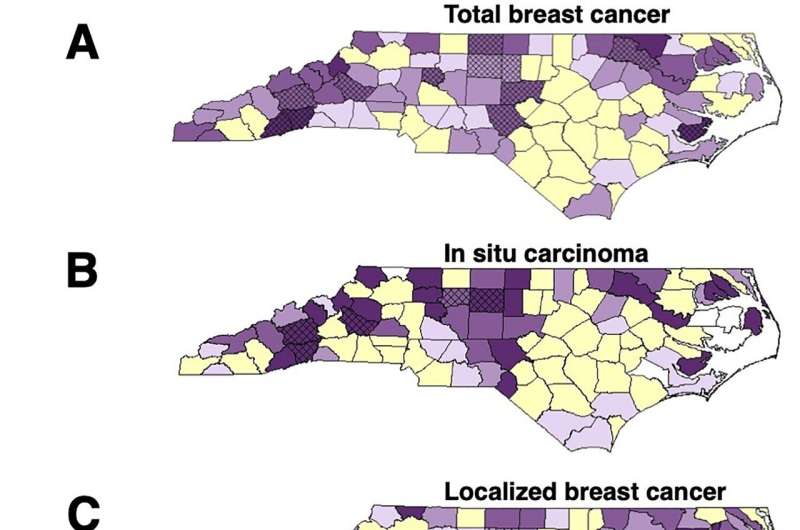This article has been reviewed according to Science X's editorial process and policies. Editors have highlighted the following attributes while ensuring the content's credibility:
fact-checked
peer-reviewed publication
trusted source
proofread
Urban environmental exposures drive increased breast cancer incidence, finds study

A Duke Health analysis of breast cancer in North Carolina has shown that the state's urban counties had higher overall incidences of disease than rural counties, especially at early stages upon diagnosis.
The findings, appearing in the journal Scientific Reports, serve as a national template for assessing the impact of poor environmental quality across different stages of breast cancer, which is marked by highly diverse origins and mechanisms for spreading. North Carolina serves as a good model; it has a diverse population of 10 million spread over 100 rural and urban counties with varying environmental conditions.
"Individual environmental contaminants have long been associated with breast cancer, but we have limited understanding of how multiple exposures simultaneously affect this disease," said senior author Gayathri Devi, Ph.D., a professor in Duke's departments of Surgery and Pathology and Program Director of the Duke Consortium for Inflammatory Breast Cancer at the Duke Cancer Institute.
"Our study explored the incidence of breast cancer within the context of the Environmental Quality Index (EQI)—a county-by-county assessment of air, water, land, built environment, as well as the sociodemographic environment," Devi said. "This type of data analysis allows for a high-level look at broader environmental factors and health outcomes," Devi continued.
Devi and colleagues—including lead author Larisa M. Gearhart-Serna, who steered the research as a Ph.D. candidate at Duke—analyzed the EQI data alongside breast cancer incidence rates from the North Carolina Central Cancer Registry. The team further evaluated the different breast cancer stages—in situ and localized (early stages), regional and distant (later stages)—stratified by rural–urban status.
"In an earlier study, we assessed how environmental conditions impact the risk of a breast cancer patient having later-stage invasive disease compared to non-invasive carcinoma in-situ," Gearhart-Serna said. "This is a continuation of that work to determine whether environmental quality and an urban environment are related to the development of more advanced tumors in a community, and if so, what stages."
In counties with poor overall environmental quality compared to those with good environmental quality, total breast cancer incidence was higher by 10.82 cases per 100,000 persons. This association was most pronounced for localized breast cancer.
The researchers also found that community-level effects of environmental exposures—notably in those counties with poor land quality, especially in the urban setting—were associated with higher rates of total breast cancer incidence. The land EQI includes exposures from sources such as pesticides, and toxic releases from industrial, agricultural and animal facilities.
Breast cancer incidence rates were also higher for later-stage disease and total breast cancer among counties with higher populations of Black residents. This is relevant as global incidence of aggressive breast cancers is higher in Black women.
The analysis found that higher mammography screening rates were associated with lower regional breast cancer incidence rates, which is relevant because improved screening is thought to decrease diagnoses of later-stage disease.
"Our analyses indicate significant associations between environmental quality and breast cancer incidence, which differ by breast cancer stage and urbanicity, identifying a critical need to assess cumulative environmental exposures in the context of cancer stage," Gearhart-Serna said. "This has the potential to develop measures to reduce disease incidence in vulnerable communities."
The research is a result of a long-standing collaboration between Duke's School of Medicine and Nicholas School of the Environment. In addition to Gearhart-Serna and Devi, study authors include Brittany A. Mills, Hillary Hsu, Oluwadamilola M. Fayanju, and Kate Hoffman.
More information: Larisa M. Gearhart-Serna et al, Cumulative environmental quality is associated with breast cancer incidence differentially by summary stage and urbanicity, Scientific Reports (2023). DOI: 10.1038/s41598-023-45693-0




















